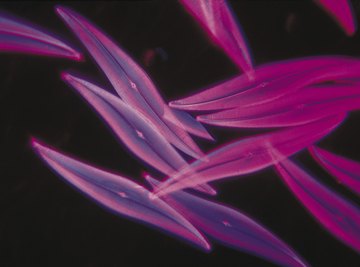
Life on Earth is primarily carbon-based. Plants and animals have to keep consuming carbon throughout their entire lives in order to grow. Despite constant carbon consumption, the planet never seems to run out of it. This is because carbon cycles through ecosystems, whether they are in water or on land. Right now, let’s focus on the aquatic carbon cycle.
Carbon Cycle Basics
Carbon is an element. It has six protons and can form up to four chemical bonds at one time, which is an impressive feat for a single atom. Because of this superpower, carbon forms the backbone of some pretty big and complex molecules. Fats, sugars, DNA and proteins are physically impossible without carbon atoms.
The aquatic carbon cycle has two basic stages: the biotic stage, and the abiotic stage. The biotic stage refers to carbon being part of a living organism, and the abiotic stage means that it is not part of something alive. Any given carbon atom will spend time in both, most typically alternating from one to the other.
The Freshwater Aquatic Carbon Cycle
Aquatic ecosystems can take one of two very basic forms as well, and there will be variations on the carbon cycle in each. In freshwater systems, like lakes and streams, carbon will enter the ecosystem as a gas called carbon dioxide.
Plants and algae adhered to the sides of streams or in the sunny, littoral zones of lakes will use photosynthesis to convert carbon dioxide into sugars for their own growth. Because gaseous carbon dioxide is not part of a living thing, scientists consider it part of the abiotic phase of the carbon cycle. However, the minute the plant converts to an organic form, like a sugar, it becomes biotic.
From there, an animal might munch on the plant, taking some of its carbon. After that, a few things might happen to a carbon atom. The fish might be eaten by a bigger fish, the fish might exhale carbon dioxide gas, the fish might die, or the fish might release waste.
Further Freshwater Transitions
At this four-pronged fork in the road, carbon can immediately go back into the abiotic phase as a gas ready to be taken up by plants again. This is the shortest, most basic loop in the aquatic carbon cycle.
If the fish is eaten by a bigger fish, then it continues through another identical biotic stage before being faced with the same crossroads later.
If the fish dies, it might sink to the bottom of the lake or stream. From there, the fish will decompose with the help of scavenging animals, fungi, and microbes. Again, much of this carbon will be converted to a gas, while some will be incorporated into longer-lived abiotic stages like soils.
The Marine Aquatic Carbon Cycle
In marine systems, the carbon cycle looks similar to the freshwater carbon cycle in a lot of ways. Photosynthesis, most often performed by plankton near the ocean’s surface, will pull carbon dioxide out of the atmosphere. These plankton are consumed by animals that either die or exhale carbon dioxide to be used by plankton again.
The big difference here is the ocean’s massive depth. Most marine animals live near the surface, but when they die, they sink all the way to the bottom, carrying their carbon with them. When it sinks to the ocean floor, carbon has a really hard time getting back to the surface and may stay at the bottom as sediment for thousands of years.
Even in the shallows, carbon can still be removed from the cycle temporarily. Coral reefs are produced by animals that build skeletons out of calcium and carbon, ultimately creating a carbon-based structure that builds up over time.
This ability to hold onto carbon is the reason why scientists refer to the ocean as a carbon sink. Carbon sinks are important because they help the planet regulate the amount of carbon cycling through the atmosphere and, by extension, help regulate the global climate.
References
Resources
About the Author
Cameron is a writer and educator based out of Fort Collins, Colorado. His work has appeared in New Scientist, LiveScience, Discovery's Curiosity Daily podcast, and MinuteEarth. He teaches Ecology and Evolution at the University of Northern Colorado.
Photo Credits
Ablestock.com/AbleStock.com/Getty Images
